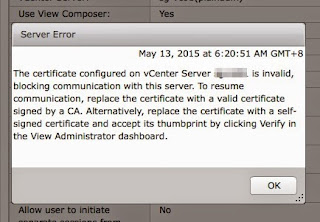VMware Multi-Core Pricing & Licensing Policy
I am been called up today on my off day but am not complaining. It got be to refer to my own post awhile back here in August after VMworld 2012 on the licensing on vSphere 4.x.
VMware actually updated the EULA on multi-core licensing and pricing which you can refer here. This has been quite while back.
There is no reason why anyone would still insist to setup a new vSphere environment based on vSphere 4.x with all the limitation and functions set.
I think the new EULA multi-core policy would explain for those who are still using vSphere 4 and have a new hardware which exceed your vSphere 4.x edition license entitlement which is pretty common having that most of them are 8 cores and above now.
The policy give you a very good example. I share just explain this with one scenario I was asked today.
I have purchased 4 x vSphere 5.x Enterprise Licenses for a server with 4 CPU of 8 cores each. I downgrade them to vSphere 4.x Enterprise. So vSphere 4.x Enterprise is limited to 6 cores per CPU.
If I were to run vSphere 5.x, I would have sufficient licenses. After I downgrade them to vSphere 4.x, the problems comes. I am having a shortage of licenses. Simpily work out each 8 cores CPU would require at least 2 x vSphere 4.x Enterprise licenses to fill up all 8 cores per CPU since 1 x vSphere 4.x Enterprisehas a limit to 6 cores per processor. Doing the math right, I would require 8 x vSphere 4.x Enterprise licenses for this server where in vSphere 5.x Enterprise I would only require 4.
Here you see, not only do you need to perform a portal downgrade of the licenses, you also just create more work for yourself and more cost. Look at it, VMware has try to minimize the licenses requirements for users when you adopt the newer version, why spend more on older version and create the the hassle and trouble?
Proper planning should always be done instead of just following the easiest way out. That is if cost is not a concern. ;)
VMware actually updated the EULA on multi-core licensing and pricing which you can refer here. This has been quite while back.
There is no reason why anyone would still insist to setup a new vSphere environment based on vSphere 4.x with all the limitation and functions set.
I think the new EULA multi-core policy would explain for those who are still using vSphere 4 and have a new hardware which exceed your vSphere 4.x edition license entitlement which is pretty common having that most of them are 8 cores and above now.
The policy give you a very good example. I share just explain this with one scenario I was asked today.
I have purchased 4 x vSphere 5.x Enterprise Licenses for a server with 4 CPU of 8 cores each. I downgrade them to vSphere 4.x Enterprise. So vSphere 4.x Enterprise is limited to 6 cores per CPU.
If I were to run vSphere 5.x, I would have sufficient licenses. After I downgrade them to vSphere 4.x, the problems comes. I am having a shortage of licenses. Simpily work out each 8 cores CPU would require at least 2 x vSphere 4.x Enterprise licenses to fill up all 8 cores per CPU since 1 x vSphere 4.x Enterprisehas a limit to 6 cores per processor. Doing the math right, I would require 8 x vSphere 4.x Enterprise licenses for this server where in vSphere 5.x Enterprise I would only require 4.
Here you see, not only do you need to perform a portal downgrade of the licenses, you also just create more work for yourself and more cost. Look at it, VMware has try to minimize the licenses requirements for users when you adopt the newer version, why spend more on older version and create the the hassle and trouble?
Proper planning should always be done instead of just following the easiest way out. That is if cost is not a concern. ;)

Comments